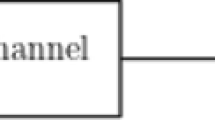Abstract
As it is often the case in public-key cryptography, the first practical identification schemes were based on hard problems from number theory (factoring, discrete logarithms). The security of the proposed scheme depends on an NP-complete problem from the theory of error correcting codes: the syndrome decoding problem which relies on the hardness of decoding a binary word of given weight and given syndrome. Starting from Stern’s scheme [18], we define a dual version which, unlike the other schemes based on the SD problem, uses a generator matrix of a random linear binary code. This allows, among other things, an improvement of the transmission rate with regards to the other schemes. Finally, by using techniques of computation in a finite field, we show how it is possible to considerably reduce:
-
- the complexity of the computations done by the prover (which is usually a portable device with a limited computing power).
-
- the size of the data stored by the latter.
Similar content being viewed by others
References
Bellare, M., Rogaway, P.: Random oracles are practical: a paradigm for designing efficient protocols. Proceedings of the 1st ACM Conference Comput. Commun. Security, 62–73 (1993)
Berlekamp, E. R.: Algebraic Coding Theory, McGraw-Hill Book Company, 1968
Berlekamp, E. R., Mc Eliece, R. J., Van Tilborg, H. C. A.: On the inherent intractability of certain coding problems. IEEE Trans. Inform. Theory, 384–386 (1978)
Berlekamp, E. R.: Bit-Serial Reed-Solomon Encoders. IEEE Trans. Inform. Theory, vol IT-28, 6, 869–874 (1982)
Canteaut, A., Chabanne, H.: A further improvement of the workfactor in an attempt at breaking Mc Eliece’s cryptosystem. Proceedings of Eurocode’94, 163–167
Chabaud, F.: On the Security of Some Cryptosystems Based On Error-Correcting Codes, Eurocrypt’94. Lecture Notes in Computer Science Vol. 950, pp. 131–139. Berlin, Heidelberg, New York: Springer 1995
Fiat, A., Shamir, A.: How To Prove Yourself: Practical Solutions to Identification and Signatures Problems. Advances in Cryptology, Crypto’86, Lecture Notes in Computer Science Vol. 263, pp. 186–194. Berlin, Hiedelberg, New York: Springer
Feige, U., Fiat, A., Shamir, A.: Zero-knowledge proofs of identify. Proc. 19th ACM Symp. Theory of Computing, 210–217 (1987)
Girault, M.: A (non-practical) three-pass identification protocol using coding theory, Advances in Cryptology, Auscrypt’90, Lecture Notes in Computer Science Vol. 453, pp. 265–272. Berlin, Heidelberg, New York: Springer
Girault, M., Stern, J.: On the length of cryptographic hash-values used in identification schemes. Crypto’94, Lecture Notes in Computer Science Vol. 839, pp. 202–215 Berlin, Heidelberg, New York: Springer 1994
Goldwasser, S., Micali S., Rackoff, C.: The knowledge complexity of interactive proof systems. Proc. 17th ACM Symp. Theory Computing, 291–304 (1985)
Harari, S. A New Authentication Algorithm, Proceedings of Coding Theory and Applications, Lecture Notes in Computer Science Vol. 388, pp. 91–105, Berlin, Heidelberg, New York: Springer 1988
Leon, J. S.: A probabilistic algorithm for computing minimum weights of large error-correcting codes, IEEE Trans. Inform. Theory, IT-34(5): 1354–1359
MacWilliams, F. J., Sloane, N. J. A.: The Theory of error-correcting codes, North-Holland, Amsterdam-New-York-Oxford, 1977
Pointcheval, D.: Neural Networks and their cryptographic applications. Proc. Eurocode’94, 183–193
Shamir, A.: An efficient identification scheme based on permuted kernels. Proc. Crypto’89, Lecture Notes in Computer Science Vol. 435, pp. 606–609, Berlin, Heidelberg, New York: Springer
Stern, J.: A method for finding codewords of small weight. Coding Theory and Applications. Lecture Notes in Computer Science Vol. 434, pp. 173–180. Berlin, Heidelberg, New York: Springer
Stern, J.: A new identification scheme based on syndrome decoding, Crypto’93, Lecture Notes in Computer Science Vol. 773, pp. 13–21, Berlin, Heidelberg, New York: Springer 1994
Stern, J.: Designing identification schemes with keys of short size. Crypto’94, Lecture Notes in Computer Science Vol. 839, pp. 164–173, Berlin, Heidelberg, New York: Springer 1994
Zierler, N.: On the Theorem of Gleason and Marsh. Proc. Am. Math. Soc., 9: 236–237, Math. Rev., 20: 851, 1958
Author information
Authors and Affiliations
Corresponding author
Rights and permissions
About this article
Cite this article
Véron, P. Improved identification schemes based on error-correcting codes. AAECC 8, 57–69 (1997). https://doi.org/10.1007/s002000050053
Received:
Revised:
Issue Date:
DOI: https://doi.org/10.1007/s002000050053




